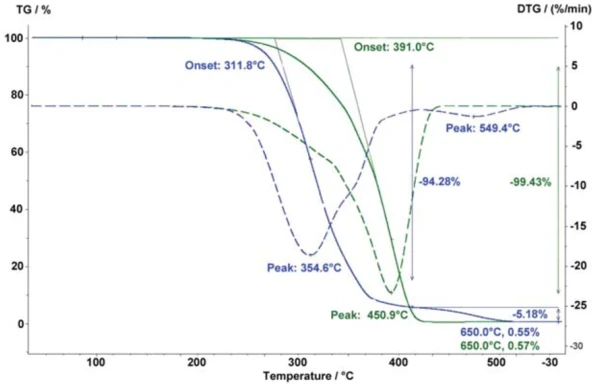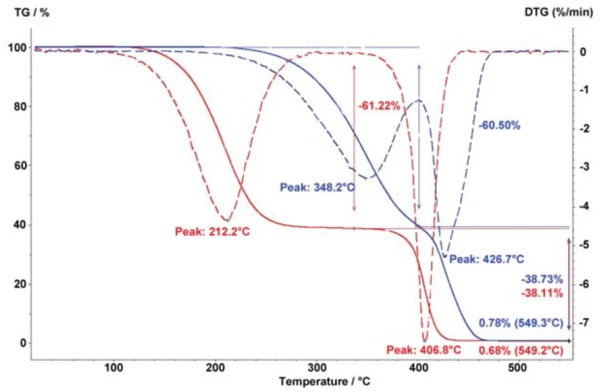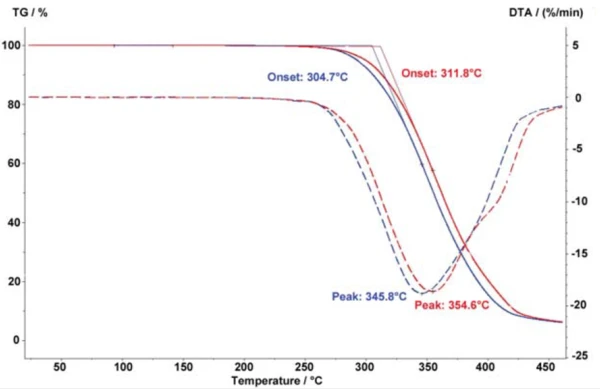Introduction
Thermogravimetry (TG) or thermogravimetric analysis (TGA) – as per ISO 11358 or DIN 51006, for example – allows for investigating the Thermal StabilityA material is thermally stable if it does not decompose under the influence of temperature. One way to determine the thermal stability of a substance is to use a TGA (thermogravimetric analyzer). thermal stability and composition of a variety of substances, materials and mixtures by heating the sample in a thermobalance under defined conditions. The surrounding atmosphere plays an important role here, so the primary focus lies on effects caused by interaction of the sample with its environment – i.e., adsorption, desorption, Reacción de DecomposiciónA decomposition reaction is a thermally induced reaction of a chemical compound forming solid and/or gaseous products. decomposition and OxidationOxidation can describe different processes in the context of thermal analysis.oxidation processes.
Under inert pyrolytic conditions (e.g., in a nitrogen atmosphere), for example, the results obtained differ radically from those obtained under oxidative conditions – i.e., in the presence of air or oxygen.
Measurement Results
Influence of the Atmosphere
Figure 1 compares the decomposition of the thermoplastic elastomer blend SEBS/PP (styrene-ethylene-butadienestyrene/ polypropylene) in a nitrogen atmosphere (green curves) to the same measurement in air (blue curves). Decomposition of the OxidationOxidation can describe different processes in the context of thermal analysis.oxidation-sensitive material clearly begins much earlier in air: 312°C as compared to 391°C (extrapolated onset) under an inert gas atmosphere. In addition, the oxidative decomposition occurs in multiple steps, which can clearly be seen in the 1st derivative. In both cases, the heating rate was 20 K/min and the sample mass was 10 mg.

Under reduced atmospheric pressure – i.e., in a vacuum – the boiling point of volatile components in a polymer mixture can be lowered, thereby allowing for a better separation from the polymer decomposition. Figure 2 shows measurements on a mixture of the thermoplastic elastomer SEBS with a low-molecular plasticizer. Under vacuum (red curves), the separation of the plasticizer occurs at a considerably lower temperature. It is thereby possible to determine the exact plasticizer content, which is here 61.2%. In a nitrogen atmosphere, the decomposition process is partially overlapped by the polymer decomposition; the DTG curve (blue dotted line) does not return to 0. A heating rate of 5 K/min was employed in both cases.

Influence of the Sample Shape: Surface-to-Mass Ratio
In decomposition analysis, the surface-to-mass ratio is also important for obtaining a reproducible measurement result. With a higher specific surface (e.g., as with powders), decomposition takes place at considerably lower temperatures and with steeper mass-loss steps than it would in bulk material of the same mass. The surface-to-mass ratio also influences the decomposition process for polymer samples, which might be available either as compact samples or cut into small pieces. Figure 3 shows the different decomposition behavior between an SEBS/PP sample which is cut into pieces (blue curves) – and therefore has a higher specific surface – as compared to a bulk sample (red curves) with an identical sample mass of 10 mg.
